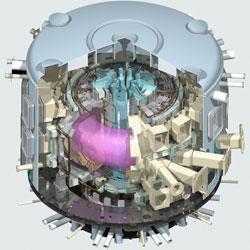Iter, the international nuclear fusion project, has secured European funding, but its new director will be keeping tight hold of the purse strings
Iter, the international nuclear fusion project, may have secured funds to meet its vastly increased construction costs, but with a new director at the helm, the project will be tightening its purse strings if it is to deliver vital information to answer fundamental questions about fusion energy.
In late July the European Commission agreed to divert €460 million (£381 million) in ’unused’ money from its seventh framework programme for research to the project for the next 2 years, and to transfer of €400 million in ’unused funds’ from other budgets, but has made it clear that there will be no further increases in funding available.

With the funding agreed, the Iter council met on 28 July to finalise its baseline - the document that lays down the final design, schedule and cost of the project - and also appointed a new director-general, fusion scientist Osamu Motojima.
Motojima has experience coordinating large fusion-related construction projects, having led the building of Japan’s Large Helical Device (a huge fusion research device). But the biggest challenge he faces at Iter will be sticking to the new budget constraints imposed by Europe - which is footing 45 per cent of the total bill. The estimated cost of Iter has nearly tripled since its inception to around €16 billion.
’Cost containment is my main priority,’ Motojima told Chemistry World. ’I want to make the management structure more centralised and task-force oriented; and simplify the design, quality control and procurement processes.’ He adds that there is scope to implement better quality controls in the design, manufacture and management of how the components all interface with each other, and to develop better contingency plans to guard against future costs.
The EC’s decision to find the necessary funds to continue to fund Iter confirms the EU’s commitment to the project at a crucial time. However, the agreed amount means that Iter will have to find several million Euros in cost savings and also rules out any further funding increases. ’The EU needs to show the vision and the resolve beyond the immediate financing difficulties,’ said Máire Geoghegan-Quinn, the European commissioner for research, innovation and science as she announced the Iter funding. ’What we are proposing is a balanced solution.’
Steven Cowley, director of the Culham Centre for Fusion Energy in Abingdon, UK, thinks that this is a positive step for fusion research. ’It’s sort of "put up and shut up" time,’ he says. ’If we don’t do Iter, we’ll never know whether fusion is viable. From a scientific point of view we can’t afford not to do it.’
However, Cowley is careful not to tout Iter as an unambiguous solution to the fusion energy problem, but sees it as an important step in that direction. ’Iter will be a demonstration that fusion is possible, not that it’s cost-effective or reliable,’ he says. ’Those are the challenges for after Iter. If Iter doesn’t work, then we close it down and spend the money on something else. But I think it will work, and it will deliver.’
Motojima echoes Cowley’s enthusiasm, ’Many people say fusion energy is a dream, but in the last 50 years, fusion energy research has progressed faster than Moore’s law for the computing power of silicon chips. Iter will show that fusion energy is achievable.’
Phillip Broadwith






No comments yet